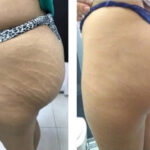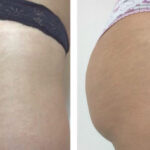What is it?
Medical Camouflage for stretch marks and scars is a tattooing method in which we camouflage scars and stretch marks with different color flesh tone pigments, its purpose is to disguise the area that is missing pigment or color. It is a permanent cosmetic service that is very popular in Brazil and the United Kingdom. Keep in mind with stretch mark camouflage; the actual stretch marks will still appear we are just covering up what we see!
What type of scars can be camouflaged?
Although scar and stretch mark camouflage can’t erase the scarred area, the most commonly addressed scars are those from facelift surgery, abdominoplasty, breast augmentation, and stretch marks.
Does it Hurt?
A topical anesthetic ointment is liberally applied to numb the skin and make the treatment comfortable but will not take the full pain away.
Will there be a lot of downtimes?
This is a noninvasive procedure. There is no bleeding, and no pain after the procedure, allowing you to return immediately to your life.
How long does it take?
Although there will be excellent results with the initial treatment, please allow two to three visits to achieve perfectly soft and natural results. Creating the illusion of protrusion, or three-dimensionally is an intricate process requiring attention to tone and shadow. The goal of each session is to perfect the design as well as correct asymmetry. Each session should take anywhere from 1-3 hours, depending on how big the area is.
How long after surgery must I wait before getting the treatment done?
A waiting period of at least 6-8 months is required to give all tissue adequate time to heal. During your consultation, we will evaluate your scar and advise on the appropriate time frame for treatment.
What to expect before and after treatment
Upon arrival, you will be asked to fill out consultation forms, and then your Licensed Provider will go over a brief recap of the consultation forms.
Your licensed professional will analyze your skin tone, and they will then test a few pigments to determine what appears to be a good match for your skin. Then they will tattoo at least one spot about the size of a pea using at least one “formula” of pigments. Medical camouflaging is an unpredictable process. Therefore, this color spot test is crucial. In all cosmetic tattooing, including permanent makeup, the final healed color looks very different from when the pigment was initially applied. The healed result equals the pigments formula that was applied to the skin PLUS your skin color and tones. This is a type of tattoo method so expect to feel a little discomfort, the numbing cream will help, but it will not completely take it away. A minimum of 2-3 sessions is required. You must have realistic expectations when it comes to Medical Camouflage for scars and stretch marks. The area being treated will not completely restore skin to the way it looked before it was injured. This process will not “erase” a scar or skin abnormality it will only make improve the color differences to help disguise.
Post Care
Keep the area dry for at least 48 hours. After 48 hours do not scrub or rub the area with soap for at least a week. Avoid using any creams, lotions, gels as well. We recommended applying coconut oil to treated areas. Tanning and or sunbathing is not recommended because the camouflage tattoo will not be a “perfect” match to the surrounding skin color. This is due to the constant changes in skin tones from blood flow, body temperature, and tanning. The pigment in the skin will not darken if it is exposed to sunlight or tanning booths, so the tattoo may appear lighter if the surrounding skin tans. Whereas when the tattoo color matches tanned skin, it may appear darker once the surrounding tanned skin fades. Therefore, if you spend time outdoors, you will need to adjust your lifestyle or decide to match the tattoo to “winter” or “summer” skin and live with the changes in between.
Overall expectations
Don’t expect results in one session! The area will most definitely improve after the first treatment, but this is a process and not a one-time “cure.” It is performed on “unhealthy” skin that has been damaged or altered. Its response cannot be predicted- a scar or Vitiligo patch may have areas that absorbed pigment, reject it, or both. The treated area will look dark and red immediately after a tattooing session, and then it takes several weeks to show the healed color (or not). This requires time and patience.



















